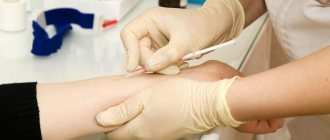→
Information
→
Vaccinal prevention
We work seven days a week and holidays
COVID 19: antibody tests
The battles between supporters and opponents of vaccination are still raging, and one of the main arguments of the latter is the child’s high temperature after vaccination. But are the fears of young mothers really justified? Let’s try to figure it out.
Any vaccination, at its core, is “infecting” a person with an infection in a very mild form, so that the body itself begins to fight it and produce protective antibodies. Naturally, any disease has certain symptoms, indicating that the body has begun to actively resist the invasion of the virus: elevated temperature is one of the main such manifestations. We can safely say that hyperthermia is a completely normal phenomenon and there is nothing to worry about: it usually does not last long and the temperature does not get too high. You just need to know exactly how long this condition should last, what form the reaction to the vaccine takes, and what to do if the consequences go beyond the recommended limits: in this article we will try to answer the questions that parents most often ask about the rise in temperature after vaccinations .
How long does the temperature last after vaccination?
As a rule, the body reacts to the introduction of the vaccine on the same day, including an increase in temperature, but there are also pauses of up to two days. The nature of the reaction depends on many factors, primarily on the characteristics of the organism itself, and on the vaccine administered, of course. Doctors usually distinguish three forms: mild, moderate and severe with temperatures up to 37.5, 38.5 and above 39 degrees, respectively. Let us emphasize once again: all this is very individual and it makes no sense to give any general assessments and recommendations. Ideally, your pediatrician should warn you if your child is at risk of hyperthermia after receiving any vaccines. By the way, it happens, although rarely, when the temperature does not rise at all after a vaccine, and this is also normal - this is how a particular organism reacts.
In most cases, the temperature returns to normal quite quickly: on the first day it is still high, on the second it begins to decrease noticeably (usually it rises slightly only in the evening), and on the third it already returns to normal. The described clinical picture can be called normal, and it is observed in approximately 70% of patients. 40% of children have a fever for 4 days, 25% for up to 5 days, and only 5% of those vaccinated are at risk of complications for a week or longer (there are different statistics, we have given one of the options here).
Hepatitis B vaccine
The hepatitis B vaccine is also given in both childhood and adulthood. In adults, vaccinations are indicated for the following categories of people:
- Patients on hemodialysis.
- Medical personnel working with blood and other bodily fluids.
- People who have sexual contact with chronic hepatitis B patients.
- Relatives of patients with hepatitis B.
Vaccination, as well as previous acute hepatitis B, provide 100% protection against re-infection. The criterion for the presence of acquired immunity is the presence in the blood of antibodies to the virus (anti-HBs) with the simultaneous absence of the virus antigen (HBsAg).
What vaccines can cause hyperthermia?
Long-term observations of popular vaccines have made it possible to assess the consequences of vaccinations, including the degree and duration of fever. In this section of the article we will answer the questions that are most often asked on this topic in search engines.
DTP
This is a “heavy” combination vaccine, and the hyperthermia in it is caused by whooping cough bacteria. The probability of a noticeable increase in temperature is very high - up to 90%, the norm is about 38.5 degrees. But the temperature drops quite quickly - within 2-3 days. The risk of hyperthermia is significantly lower when using an analogue - the French vaccine Pentaxim: it uses a fundamentally different vaccine against whooping cough, which gives fewer complications and a less significant increase in temperature.
BCG
It is placed shortly after birth and does not lead to a noticeable increase in temperature - usually within 37.5 degrees. As with most other vaccines, it returns to normal on the third day.
Hepatitis B
Just like BCG, the hepatitis vaccine is given to newborns, and the reaction is approximately the same, with a slight increase in temperature.
Measles rubella mumps
Live vaccines against these diseases usually do not cause any serious complications; if the temperature rises, it is only slightly.
Polio
As a rule, the vaccination is easily tolerated, the temperature does not exceed 37.5 degrees.
Mantoux
Mantoux is not a vaccination, but a diagnostic test for tuberculosis, but many are still interested in whether the temperature can rise after mantoux. In general, this should not happen, so if there are signs of hyperthermia, you should consult a doctor.
Pneumococcus
This is a relatively new vaccine, so reliable statistics on its effects have not yet been accumulated. At the moment, it is believed that the temperature after pneumococcal vaccination should not exceed 38 degrees and last longer than two days. Although cases of hyperthermia have also been observed.
Flu
Hyperthermia after a flu shot is a normal reaction, since vaccines contain live microorganisms, and their appearance in the human body causes the same symptoms as with the disease itself. As with most other vaccinations, the temperature should return to normal on the 3rd day.
Prevenar
Symptoms after administration of the Prevenar vaccine are the same as for any other pneumococcal vaccines, that is, the temperature is relatively rarely high and subsides on the third day.
Infanrix hexa
This is an analogue of the domestic DTP, only it includes vaccines against a larger number of diseases. And as with DTP, a high temperature is often observed from the whooping cough component included in the vaccine. Hyperthermia usually lasts three days.
Menactra
This vaccination against meningococcus is tolerated quite easily and can be considered slightly reactive. Cases of hyperthermia are rare, although, of course, they do occur; the temperature returns to normal on the 3rd day.
Rotatek
Vaccination against rotavirus infections is usually easily tolerated, and hyperthermia is rarely observed.
Video on the topic
Dr. Komarovsky about the increase in temperature after vaccination:
If your baby has a fever after the DTP vaccination, do not despair. Elevated levels (no more than 39 C) indicate a normal reaction of the body to the pathogen. In such cases, the main task of parents is to carefully monitor the baby’s condition, as well as use the usual medications.
As a rule, this is quite enough to survive the post-vaccination period painlessly and without any consequences. In order to prevent complications and save yourself from additional worries, you should ask your doctor in advance about the duration of the period of hyperthermia, as well as about the set of possible manifestations that are considered to be the absolute norm after the administration of the DPT vaccine.
Observation after vaccination
If we talk specifically about the risk of hyperthermia, then after vaccination it is necessary to measure the temperature every 4-6 hours. If the temperature rises noticeably, check more often and begin to bring it down. Please note that hyperthermia may return even after the temperature has stabilized, so check for it within a week after vaccination.
There is no consensus on whether it is necessary to lower the temperature after vaccination, but they are usually guided by the same principles as with a common viral disease: you should not interfere up to 38 degrees, and above that you should give antipyretics. However, this is all very individual, and there are situations when it is necessary to react even to a low temperature, for example, with a noticeable general deterioration in the condition or with a tendency to seizures and neurological diseases.
How to relieve the condition
Post-vaccination reactions are not only an elevated temperature, so first create a calm environment, do not force children to lie in bed all the time - they do not like this, do not burden them with any activities, refrain from walks. General recommendations include regularly ventilating the room, giving more fluids and not forcing people to eat, as appetite decreases after vaccination. Of particular note is the ban on aspirin - it has too many side effects.
As for the methods of reducing the temperature, they are the same as for any viral diseases: give Paracetamol or Nurofen, wipe with a damp cloth - everyone has their own favorite methods, we will not describe them here.
Features of hyperthermia in infants
One of the peculiarities of infants is that they have a normal temperature of approximately 37.3 degrees, and its increase after vaccinations is observed less frequently. It is also important to know that hyperthermia in infants develops much more rapidly, so measures must be taken even with a slight increase in temperature to 37.5 degrees.
The body's reaction to the Sputnik V vaccine
On the first day after being vaccinated, some patients do not observe any changes in their condition. For example, photographer from Omsk Alexander Yarkov said:
“In the morning the injection site hurt slightly, and by lunchtime the temperature rose sharply to 38 degrees, weakness, aching bones and muscle pain appeared. I decided to go to the store and take a walk in the fresh air. It was as if I got up after a two-week illness and went outside for the first time. Out of habit, I decided not to use the elevator - I had difficulty getting to the apartment. I came home, took Paracetamol and lay down, and by the evening my condition returned to normal.”
Most patients report that there was nothing other than a mild fever. As Evgeniy from Dnepr said:
“I got my first vaccination. The maximum that happened was that the temperature rose to 37.5, I drank the powder, and everything went away. I hope that after the second vaccination I will feel no worse.”
But some vaccinated people say that flu-like symptoms lasted for several days. Anna Evgenievna from Chelyabinsk shared her feelings:
“10 hours after the injection, the temperature rose to 38 degrees. I felt chills, trembling and body aches. It felt like I had a cold or caught the flu. It was bad for 12-15 hours, then it went away a little. In general, the symptoms came and went for four days, then it got better.”
It is difficult to unambiguously assess the reaction after vaccination - each organism tolerates the procedure in accordance with its individual characteristics. It has been noted that people with weakened immune systems, chronic diseases and the elderly tolerate vaccination less well. Therefore, before vaccination, they should definitely consult a doctor and find out whether there is a risk of developing serious complications.
Child speech development
Your child, as a social being, strives to communicate. For a baby, the best company is you. Talk to him, take him with you on errands, play around, sing him a song.
The child’s speech develops, new sounds appear, new intonations, new emotions for what he sees and hears. The baby shows a desire to communicate with you. When you talk to him, he listens to you carefully (listens). Of course, the child does not yet understand your language and the essence of what you told him, but he has a desire to communicate with you. Please note - he reciprocates your feelings (with a smile or cooing, actively moving his arms and legs), but only after you have finished addressing him. Scientists conducted an experiment. They took an ordinary bell and after each sound the child made, they created a melody with the bell, after which the child silently listened to the melody and was silent. And only after the baby heard the man’s voice, he began to “talk” again.
Many children like to “listen” to dance music or calm, quiet music. Give your baby this opportunity! Maybe there is a future Vivaldi in your crib!
Very often, kids like to “talk” to themselves. By playing with their hands, they “produce” different sounds. Scientists have proven that a child whose movements are not limited (for example, swaddling) grows up calm, unlike children who lack communication and “vocality.”
Make it a rule to talk to your child as much as possible. Voice all your actions. If you are changing your baby's clothes, name the objects with which you interact and the parts of the body that you dress. For example, “Where is our left handle? Here is our left handle. Let’s dress her in the sleeve of a green blouse.” Or, for example, “Let’s put a yellow sock on our right leg,” etc. Thus, you and your child will gradually study parts of the body (arms, legs, head, tummy), as well as the concepts of “right”, “left”, tell your child what types of clothes there are, what the parts of clothing are called (collar, sleeve, button) , introduce him to flowers. When putting on a new blouse or suit, pay your child’s attention to what is drawn on these things (ball, flowers, bunny, cat). In this way, you will make an invaluable contribution to the development of your baby's speech.
Care
You have probably already learned how to properly care for a baby, and yet, admit it, there are problems that you cannot always cope with. For example, a baby suffers from flatulence or colic. To alleviate his condition, you can resort to various techniques, for example, do a light massage of the tummy in a clockwise direction, then put the child on his stomach for a couple of minutes, and then, turning him over, apply a warm compress to this area. Gas tubes are also used, but you should not master this procedure on your own; ask your pediatrician or nurse to show you how to do it. Often, when such methods do not help, you have to resort to drug treatment prescribed by a doctor.
Every morning, wipe your child’s eyes from the outer edge to the inner with a cotton swab dipped in clean water. Then wipe your entire face with another cotton swab soaked in clean water. At this age, the baby’s lacrimal glands are already functioning. Use cotton wool to clean your child's nose and ears. Nails should be cut regularly, but not short, rounded on the hands and straight on the feet.
The baby can no longer be swaddled. Toys should be clean and easy to wash. Do not give your baby small objects or toys with sharp edges. Now is the time to secure your home. Remove valuables, cleaning supplies and plants from reach. Anything your child can reach should be unbreakable and non-toxic. Make sure that he does not find small objects that he could choke on.
Why did the temperature rise?
It should be remembered that an increase in body temperature after almost any vaccination is a natural process, since a vaccine, by definition, provokes the development of an inflammatory response of the immune system. As a result of this reaction, antibodies begin to form, which guarantee a person’s protection from contracting any infection.
If we talk about coronavirus, scientists give approximately a 90% guarantee that vaccination will help avoid infection and provide a milder course of the disease in case of infection. Some time ago, scientists assumed that the degree of temperature increase determines the amount of antibodies produced, but later abandoned this hypothesis. Additional studies were conducted, during which it was found that people who received the vaccine with severe symptoms and those who did not experience side effects developed approximately the same number of antibodies.
Feeding
Some order begins to be seen in his behavior: he wakes up at a certain time - hungry or in the mood to play. It is very important now to start practicing a clear ritual for going to sleep at night. Feed and bathe your baby at the same time. This is especially important for babies who cry frequently or act fussily. A week or two will pass, and you will feel all the advantages of a solid daily routine.
It is very difficult to keep track of how much milk your baby eats when he is only breastfed. But it is known that a baby eats 800 - 850 g per day. That is, a child eats 120 - 140 g at a time. You can calculate the required amount of milk in another way: Divide the child’s weight by six. The result obtained is the amount of milk that the baby needs to eat.
For breastfed babies, mother's milk is sufficient for now. But you need to watch your diet: your diet should have enough proteins, vitamins, and minerals. It is very healthy to eat lean pork, milk, cottage cheese, fish, buckwheat and oatmeal, rye bread, and as much raw fruits and vegetables as possible. But with carrots, tomatoes, and citrus fruits you need to be careful. You will have to give up for a while fatty and fried meat, strong meat and fish broths, legumes, as well as various hot seasonings and sauces and, of course, alcohol. If breast milk is of poor quality, the baby gains little weight, has tummy problems, etc.
When a mother, for some reason, cannot breastfeed her baby, he is transferred to artificial feeding. With the current variety of baby food products, you can bring the feeding process as close as possible to natural: it is important to choose the right milk formula. But feeding a baby from a bottle has its own characteristics. It is best to hold the baby not in a horizontal position, but at an angle of 30 degrees. - this makes it easier for him to swallow and less likely that he will choke. To ensure an even flow of milk and prevent the nipple from sticking, periodically invert the bottle or remove the nipple from your baby's mouth for a few seconds. Keep the bottle at an angle at all times so that the nipple is completely filled with milk, otherwise the baby may swallow air.
An approximate scheme for feeding a child in the third month of life is provided in the table.
| Watch | Menu | Volume of food per feeding, ml |
| 6.00 | Breast milk or formula | 150 — 160 |
| 9.30 | Breast milk or formula | 150 — 160 |
| 13.00 | Breast milk or formula | 150 — 160 |
| 16.30 | Breast milk or formula | 150 — 160 |
| 20.00 | Breast milk or formula | 150 — 160 |
| 23.30 | Breast milk or formula | 150 — 160 |
While the baby is awake, namely, after feeding, 25-35 minutes later, it is necessary to lay the baby on his tummy so that he can train his neck muscles and learn to hold his head. Talk to your child from the first days of his life, try to evoke his visual and auditory attention.
The child must be given vitamin D. The pediatrician will prescribe how and how much to give it to the child.









